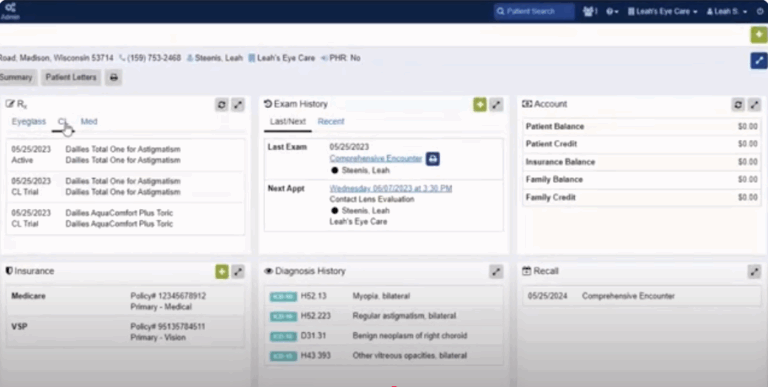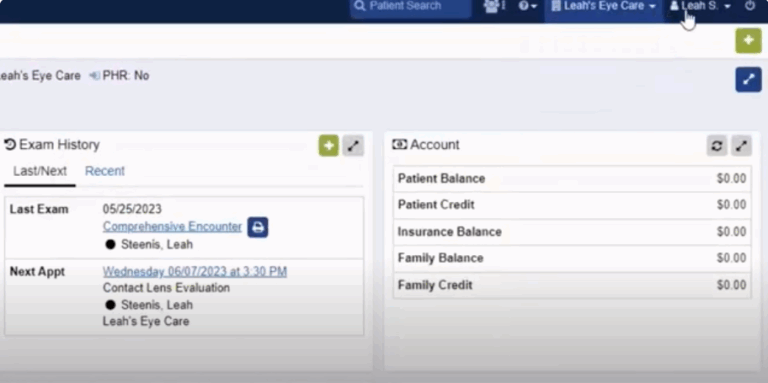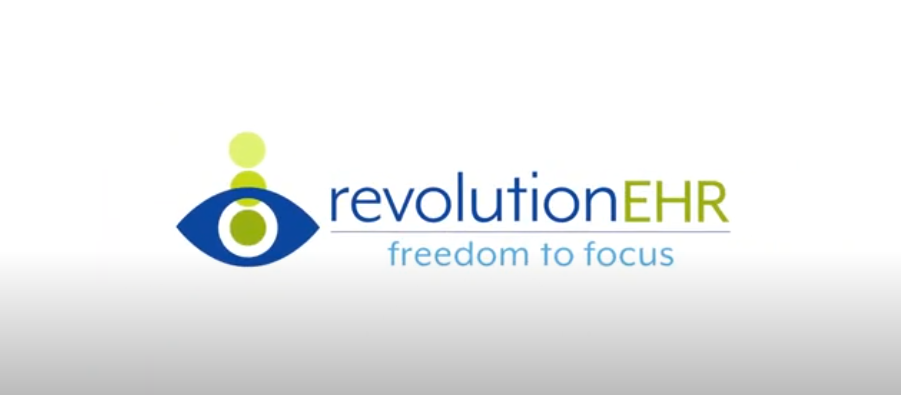Revolution EHR is a specialized, cloud-based EMR solution designed exclusively for optometry and eye care practices.
What makes it different?
It was actually created by optometrists for optometrists, which explains why over 13,000 eye care professionals trust it with a 97% retention rate.
While most EMR systems try to be everything to everyone, Revolution EHR focuses solely on eye care. Instead of generic medical software, it’s dedicated exclusively to optometry practices, combining electronic health records, practice management, and billing into one system.
For a comprehensive comparison of all optometry EMR options available, check out our complete optometry EMR guide.
This guide is for eye care practice owners and decision-makers evaluating EMR options. Whether you’re a solo optometrist looking for something affordable and user-friendly, managing multiple locations that need centralized workflows, or running a specialty practice requiring advanced customization, we’ll help you determine if Revolution EHR fits your needs.
We’ll walk you through the platform’s strengths, weaknesses, and real-world costs so you can make an informed decision about whether this optometry-focused solution makes sense for your practice.
Key Features and Functionality
Revolution EHR brings together all the essential tools optometry practices need in one integrated platform. Here’s what you get when you dive into the system’s core capabilities.
Patient Charting and Documentation
Revolution EHR’s charting system was built with optometry workflows in mind. The platform lets you customize exam templates to match exactly how you practice, whether you’re doing routine vision screenings or complex specialty procedures. What’s particularly helpful is that data from previous tests automatically populates in patient charts, which cuts down on repetitive data entry during busy days.
The system understands that every optometrist works differently, so you can tailor the medical exam process to fit your specific workflow. Templates can be customized on the fly, and patient eye health history is easily accessible with just a few clicks. Since it was designed by optometrists, the charting feels natural rather than forcing you to adapt to generic medical templates.

Scheduling and Appointment Management
The scheduling system handles the complexities that come with running an eye care practice. You can easily book appointments, reschedule patients, and avoid those frustrating double-bookings that throw off your entire day. The calendar views give you a clear picture of your schedule, and the system can handle complex scenarios like follow-up appointments for specialty care.
Appointment reminders help reduce no-shows, and the system manages confirmations, cancellations, and rescheduling automatically. For multi-location practices, you can view schedules across all sites from a single dashboard.
Billing and Revenue Cycle Management
Revolution EHR integrates billing directly into the patient encounter workflow, so you’re not jumping between different systems to handle claims. The platform automates claims submissions and helps track reimbursements, which takes some of the headache out of revenue management.
The system generates billing reports and manages the entire revenue cycle from patient visit to payment collection. For practices dealing with insurance complexities, the integrated approach means fewer billing errors and faster claim processing.
Understanding EMR costs and pricing models can help you evaluate Revolution EHR’s value proposition against other systems.
Clinical Decision Support Tools
The platform connects with major diagnostic equipment used in optometry, automatically pulling data into patient records during exams. This integration means you’re not manually entering information from multiple devices – everything flows seamlessly into the patient’s profile for documentation and prescribing decisions.
All diagnostic data is securely linked to patient profiles, giving you a complete picture when making clinical decisions. The system supports evidence-based care by keeping all relevant patient information readily accessible during encounters.

Reporting and Analytics Capabilities
Revolution EHR provides robust reporting tools that help you understand your practice’s performance. You can track revenue patterns, patient flow, and practice efficiency metrics. The analytics help identify trends in your patient base and can inform business decisions about staffing, scheduling, and service offerings.
Reports can be customized to show the specific metrics that matter most to your practice, whether that’s tracking certain procedures, monitoring patient outcomes, or analyzing financial performance across different time periods.
Mobile Accessibility and Remote Access
Since Revolution EHR is entirely cloud-based, you can access patient records and practice information from anywhere with an internet connection. The system works on smartphones, tablets, laptops, and desktop computers without requiring special software installations.
This remote access proved particularly valuable during the pandemic when many practices needed flexibility in how and where they worked. You can check patient charts from home, review schedules on your phone, or access the system from multiple locations if you operate satellite offices. The web-based platform means you’re not tied to specific devices or office computers to manage your practice.

Pricing Structure
Revolution EHR uses a straightforward subscription-based pricing model designed to scale with your practice size. For context on how this compares to other optometry EMR pricing, here’s what you need to know about the costs involved.
Subscription Models and Pricing Tiers
Revolution EHR costs a monthly subscription fee starting at $299, though some sources indicate pricing starts at $385.00 per month. The pricing is customizable and includes a monthly subscription fee based on the number of doctors in your practice.
The system uses a tiered pricing structure that becomes more cost-effective as you add providers:
|
Provider Number |
Monthly Cost |
|
First Doctor |
$385 |
|
Second Doctor |
$275 |
|
Third Doctor |
$165 |
|
Fourth Doctor |
$115 |
Once you subscribe, you and your staff have unlimited access to the EHR, including those in different locations and on all devices.
This fee covers all software features, updates, and data management, which means you won’t face surprise charges for basic functionality that other EMR systems sometimes treat as add-ons.
Implementation Costs
Beyond the monthly subscription, you’ll need to budget for several one-time costs to get your practice up and running with Revolution EHR.
The company charges a one-time service fee and database conversion fee to help create a smooth transition to RevolutionEHR’s optometry software. Their data transfer team has experience converting over 70 different practice management systems and over 10 different EHRs into RevolutionEHR.
While specific implementation costs aren’t publicly disclosed, most practices should expect setup fees that typically range from a few hundred to several thousand dollars, depending on the complexity of data migration and customization needs.
It’s best to talk to the RevolutionEHR team so they can customize a quote based on your requirements.
Who Should Consider Revolution EHR?
Revolution EHR isn’t the right fit for every practice, but it excels in specific situations. Here’s who should seriously consider this platform and who might want to look elsewhere.
Best Fit Practice Types and Sizes
- Solo Practitioners and Small Practices: The tiered pricing makes it affordable for solo optometrists and small practices with 2-4 doctors. The comprehensive feature set eliminates the need for multiple software systems.
- Multi-Location Eye Care Groups: The cloud-based architecture allows centralized management of schedules, patient records, and billing across all locations from a single system.
- Established Practices Transitioning from Paper: Revolution EHR has proven success helping traditional practices move to digital systems with extensive customer support and optometry-focused training.
- Growing Practices: The scalable pricing and robust feature set work well for practices that expect to add providers or locations without switching systems.
Specialties that Benefit Most
- General Optometry Practices: Perfectly tailored for routine eye exams, vision correction, contact lens fittings, and basic eye health screening.
- Contact Lens Specialists: Strong integrated contact lens ordering, parameter validation, and inventory management features.
- Optical Retail Operations: Seamless integration between clinical examinations and eyewear ordering within the same platform.
- Corporate and Franchise Eye Care: Standardized workflows and centralized management provide consistency across multiple locations.
Practices That Might Want Alternatives
- Medical Ophthalmology Practices: The system is optimized for optometric care rather than complex medical documentation and surgical workflows.
- Practices Requiring Extensive Medical Integration: Deep integration with hospital systems or complex medical workflows might need medical-focused EMRs.
- Very Large Organizations: Hundreds of providers might need more enterprise-focused solutions.
- Budget-Conscious Startups: New practices with tight budgets might find basic EMR solutions more affordable initially.
Conclusion
Revolution EHR is an excellent choice for most optometry practices focused on routine eye care, contact lens services, and optical retail. The optometry-specific design eliminates frustrations common with generic medical EMRs.
Solo practitioners and small to medium-sized optometry practices looking for an all-in-one solution should seriously consider Revolution EHR. Budget adequate time for training and expect temporary productivity loss during transition, but the long-term benefits typically justify the initial investment.
Consider conducting a thorough EMR cost-benefit analysis to quantify the expected return on investment for your specific practice.
Practices heavily focused on medical eye care or surgical procedures should evaluate medical-focused EMR systems alongside Revolution EHR.
Get Your Free EMR Price Quotes
Ready to see if Revolution EHR is right for your practice? Get customized quotes from Revolution EHR and other top optometry EMR systems to compare features, pricing, and implementation timelines.
Get Your Free EMR Quotes: Our EMR specialists understand optometry practices and can help you navigate the selection process with personalized pricing quotes, feature comparisons, and implementation estimates.
Fill out our quick form to connect with specialists who’ll ensure you have all the information needed to make a confident decision about your practice’s future. Take the first step toward modernizing your practice today.
